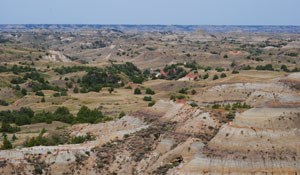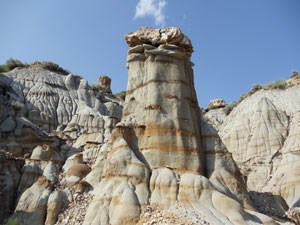|
The landforms of western North Dakota have long been called by this strange name: badlands. Places with similar features are also called badlands. But what does this name mean? Where did it come from? And are the lands really that bad? The first humans to see this area were Native Americans. Modern tribes like the Lakota called this land "mako sica" (mah-koh see-kah). This has been translated into "badlands." Some of the first European explorers came up with similar names. French traders called it a "bad land to travel." 
NPS photo by Laura Thomas Imagine traveling east to west across the Great Plains of North America. You see flat, rolling, grass-covered land for miles. This is pretty easy to travel through. Then you come across canyons of loose rock and mud. There is no more grass and the land is not flat. Strange landforms and hills make it hard to get across this area. This stretches on for miles. There is little water and not much to eat. What was an easy journey is now very difficult. You are in a bad land! Harsh to live in, the Badlands are a beautiful place to visit. Theodore Roosevelt said the Badlands do not seem to belong to this earth. Other areas in North America are also called badlands. Nebraska, Montana and Alberta (Canada) are just a few places that have badlands. Full of color and strange shapes, the Badlands are a great place to learn about geology! Geology of the Badlands Geology is the study of the earth. The Badlands let us see ancient layers of the earth without having to dig or make computer models. You can walk into Theodore Roosevelt National Park and see rocks that were created millions of years ago! These rocks are visible because of two things: weathering and erosion. If you learn geology, you have to know these two words! Weathering is when rocks break apart; erosion is when stuff starts to move! There are different types of each idea, but that is a basic definition. About 65 million years ago (give or take a few million!), the place we call North Dakota was a warm, swampy ecosystem. It supported many fish and reptile species. To the west, the Rocky Mountains were forming. As volcanoes erupted their ash dumped into the swamps. Erosion from the mountains also filled up the wet places. This means some layers you see in the Badlands are actually old mountains! These layers of ash, sand and mud are called sediments. When they are buried for a long time they squish together to form rocks. We call them sedimentary rocks. Sandstone, limestone, and shale are types of sedimentary rocks. 
NPS photo by Joe Bruce Creating the Badlands Our badlands was a flat, swampy place. Sediments were buried and turned into rocks. Now we fast forward to about a million years ago. North America was in a long ice age. The ice moved south from Canada and started changing how rivers flowed. After millions of years the rocks and sediments faced a new force of erosion: the Little Missouri River. The Little Missouri River flows through western North Dakota. Water will follow the easiest path. The river carved into the soft layers of the earth. Some layers were much harder and protected the softer layers. This type of erosion can create pillars we call hoodoos! A hoodoo is a pillar with a hard rock or fossil on top. This top part is called the caprock. Some are just inches tall, but others tower above your head! Over time the harder rocks stayed behind while the soft sediments eroded away. Thousands of years of weathering and erosion created the shapes and landforms of today's badlands! Keep reading to learn more about these landforms and the habitats they provide. You can also return to the first Learn About the Park page. Go to the vocabulary page to review the blue words you learned here. |
Last updated: August 19, 2015
